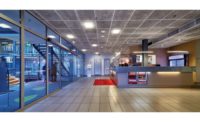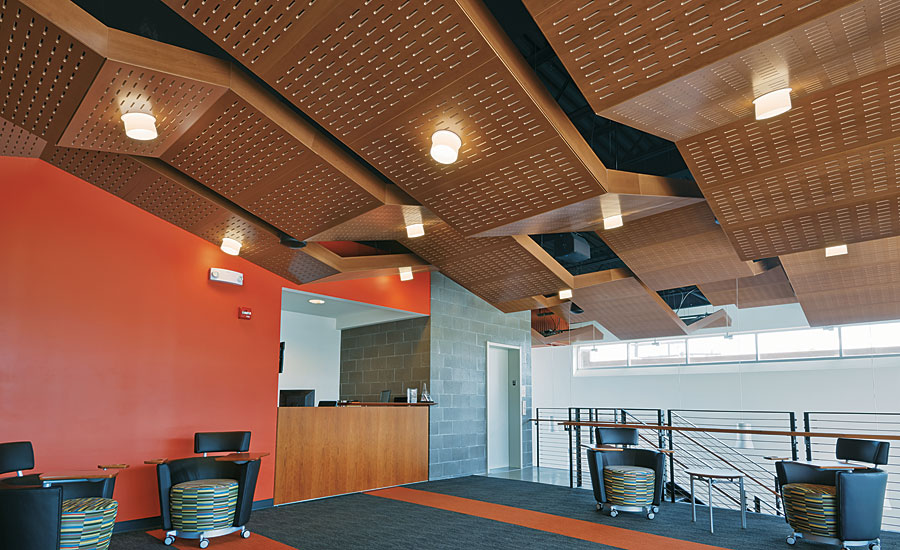When visitors enter the lobby of the new Lyric Opera administration building in Kansas City, their eyes are immediately drawn to the unusual design of the ceiling above them.
The ceiling, which was designed by Hu Jarvis Meyer Architects of Kansas City, Mo., was created by suspending ribbons of wood veneer ceiling panels above the two-story lobby and reception area.
When designing the signature space, HJM chose a wood ceiling to offset the industrial aesthetic of the glass and steel building which houses the opera company’s administrative offices and provides storage space for its sets. “It’s a very industrial-looking building and everything is kind of exposed,” says design team leader Richard Hu. “We needed a warm material to offset all those cold, hard surfaces.
Located in the heart of Kansas City’s Crossroads Arts District, the building often serves as a venue for a variety of receptions and fundraising events. “The first floor lobby is all concrete,” explains Hu. “It can get pretty noisy in there, so we wanted a ceiling that would control acoustics as well.”
Working with the You Inspire Solutions Center at Armstrong, the design team accomplished its design intent by installing a WoodWorks Custom Concealed Ceiling System above the lobby and second-floor reception area. The concealed ceilings help create a rich, natural, custom look using only standard panels and grid.
Acoustical Clouds
The ribbon pattern was created by installing five acoustical clouds consisting of wood veneer ceiling panels at 30-degree angles above the space. Four of the five clouds measure 40½ feet by 4 feet in size. A fifth cloud, which extends only above the first-floor lobby area, is 13½ feet by 4 feet in size.
Each cloud consists of a single row of standard 2-foot by 4-foot ceiling panels in a dark cherry veneer with coordinating 6-inch perimeter trim and a narrow 1/4-foot reveal between each panel. The panels are perforated in a straight-slotted oval pattern and backed with a fiberglass infill for acoustical control.
“These are all standard products that were used to create a cost effective, custom design,” says Armstrong design support manager Bill Commella. “Taking a standard product that was intended to be installed flat and ending up with a design like this, there’s a little bit of magic in that.”
Acoustical ceiling contractor Allied Construction of Kansas City, Kan., installed the ceiling clouds on a standard Armstrong Prelude heavy-duty 15/16-foot suspension system. The contractor used standard DW30 clips to create 30-degree angles in the clouds and screw attached the panels to the suspension system to hold them in place at the right angle. Using standard aluminum trim, the contractor miter cut 30-degree angles into each end of the trim and created custom splice plates to hold the trim in place on the angled panels.
Suspending the faceted ceiling clouds above different floor levels presented its share of challenges, according to Allied Construction project manager David Bennett. “Working over the stairway between the lobby and reception area was difficult,” he explains. “We had to scaffold the whole area and use scissor lifts to work at the different elevations.”
The Rich Look of a Tapestry
The design team was pleased with the end result, noting that the wood veneer ceiling panels warm up the space and improve acoustics in the noisy lobby and reception area. “The ceiling softens the space acoustically and visually,” says Hu.
The ribbon pattern helps break up the volume of the two-story lobby and creates a visual connection between the lobby and the upper reception area. “We were trying to do something dynamic that drove people directionally to the upper lobby—to create some motion that way,” explains Hu. “The ceiling design provides very subtle way finding, but also a nice, rich look—almost like a tapestry.”















